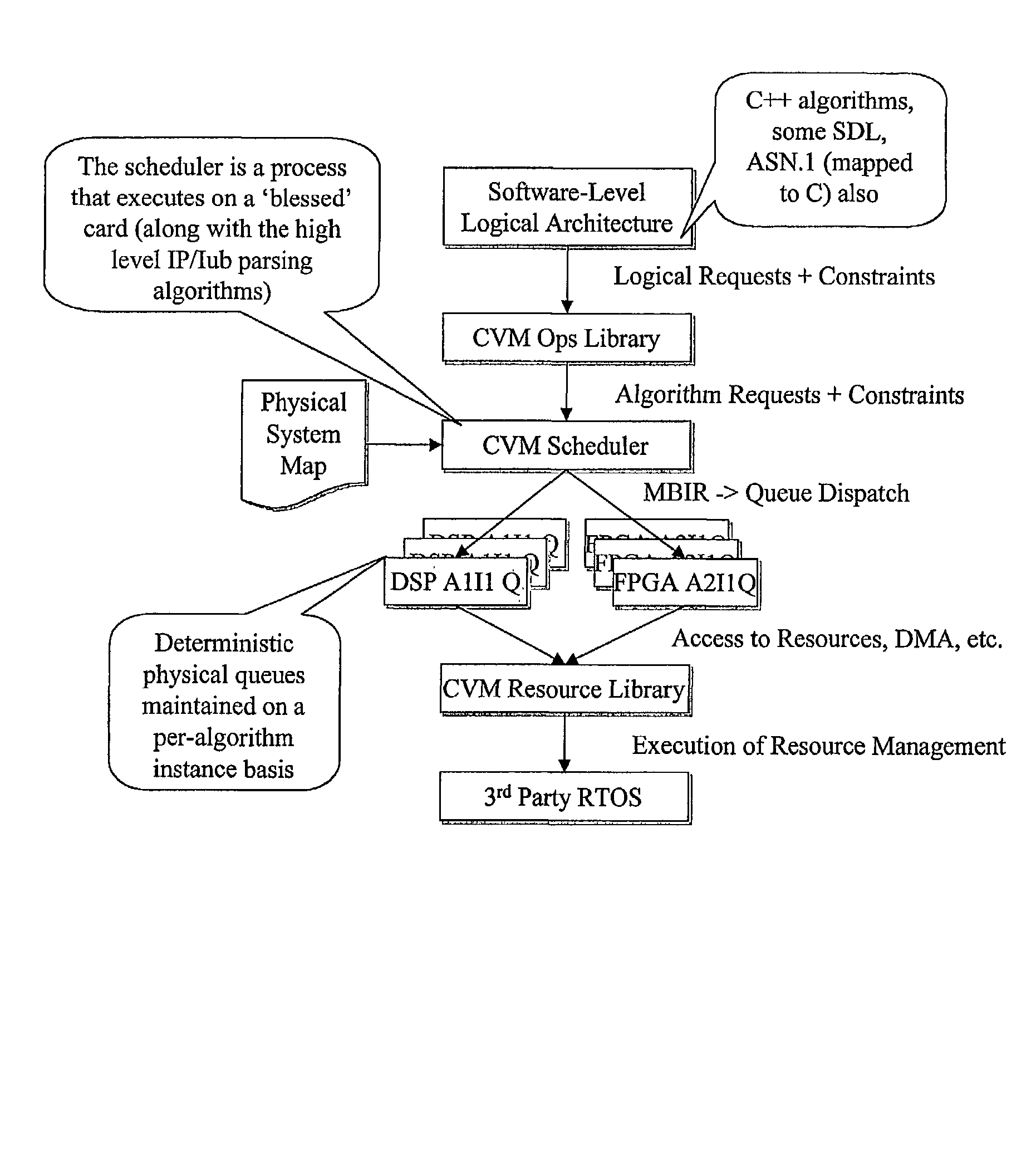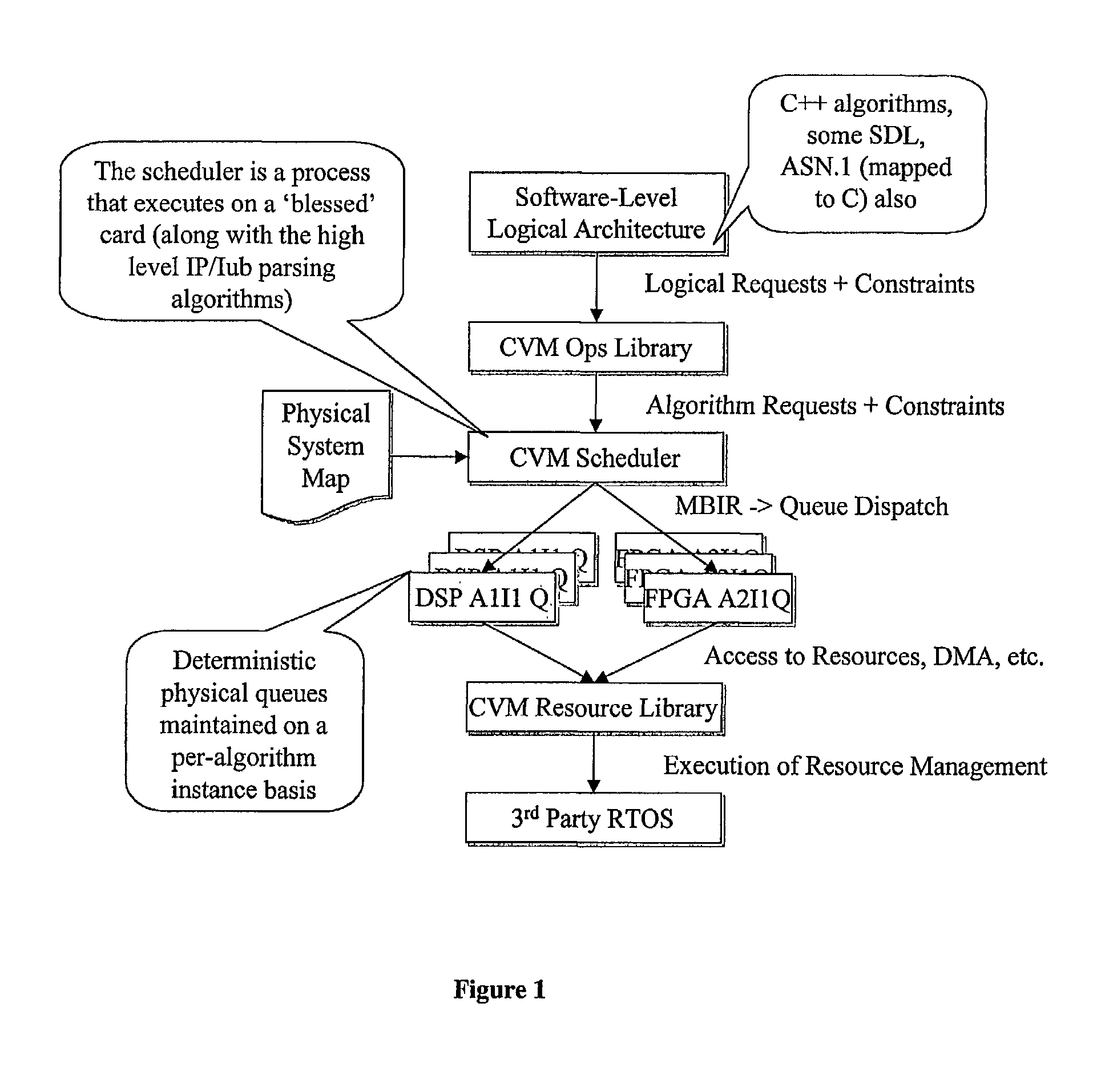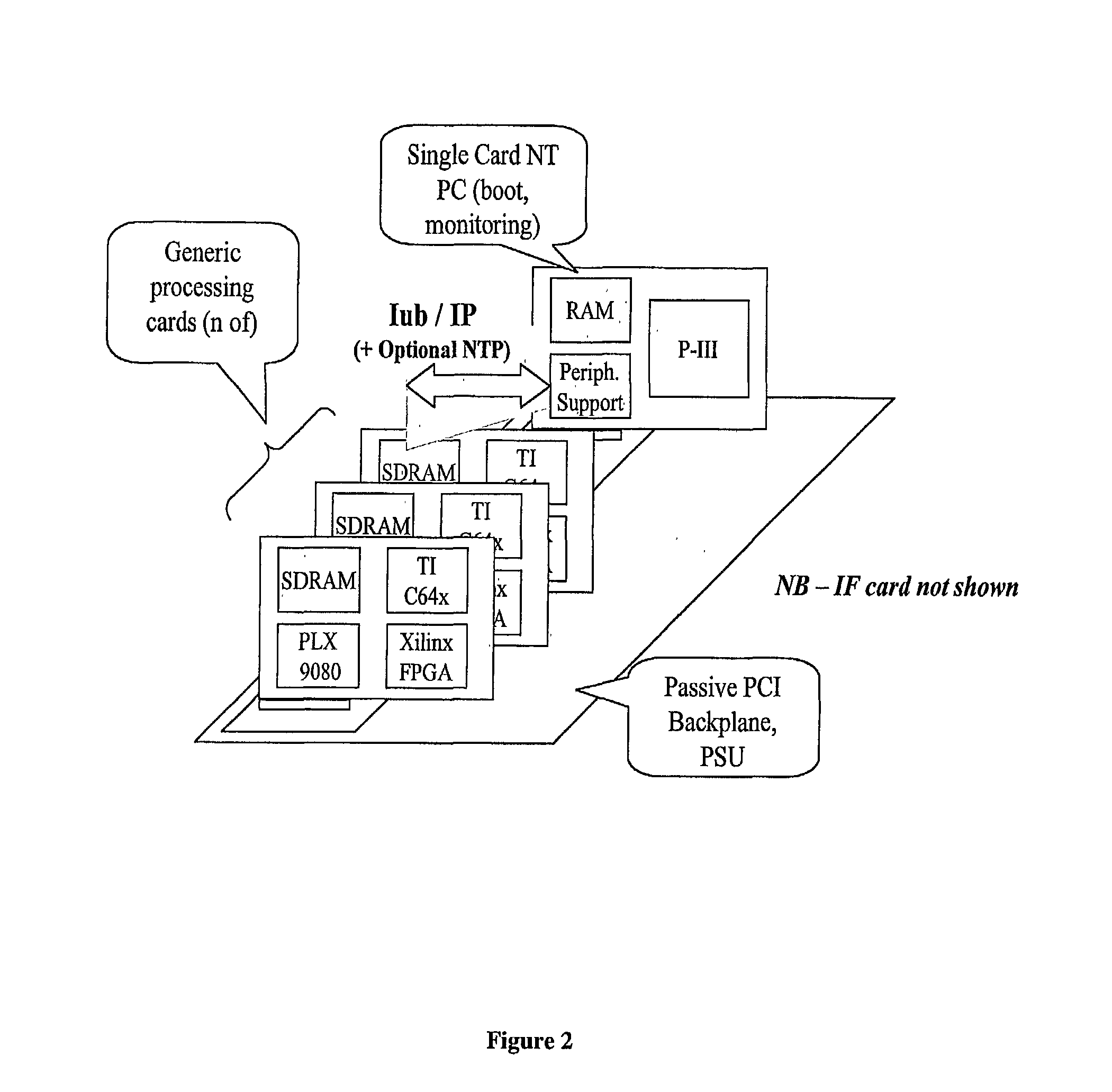These kinds of hardware based digital wireless communications basestations can take over a year to produce, and have a large development expense associated with them.
Whilst
software architectures have also been used in digital wireless communications basestations, they have tended to be very monolithic and intractable, being based around non object-oriented languages such as C, limited virtual machines (the RTOS layer), and non-intuitive hardware description systems such as
VHDL.
Closed (or effectively closed) interfaces into the basestations have led to the necessity to use that vendor's
base station controllers also, further reducing choice and driving down quality.
And significant changes in the underlying communications standards have all too often required a `forklift
upgrade`, with hardware having to be modified on site.
Digital radio standards (such as UMTS) are however so complex and change so quickly that it is becoming increasingly difficult to apply these conventional hardware based design solutions.
Previously, closed, proprietary interfaces have been the norm; these make it difficult for RF suppliers with highly specialised analogue design skills to develop products, since to do so requires a knowledge of complex and fast changing digital basestation design.
The point of this enterprise is that, although the whole 3G development has supposedly been driven by the needs of data (higher bursty bandwidth for IP packet data across increasingly flat backhaul cores), in fact it is rather difficult, as a software or data vendor, to make use of the facilities offered by the underlying network.
Unfortunately, however, until recently this fraternity has been operating in the equivalent of the stone age,
cut off from the PC platform because it has an entirely different set of
algorithm requirements from the business / home application space.
These devices can take over a year to produce, and have a large development expense associated with them.
Furthermore, such software architectures as do exist have tended to be very monolithic and intractable, being based around non object-oriented languages such as C, limited virtual machines (the RTOS layer), and non-intuitive hardware description systems such as
VHDL.
Closed (or effectively closed) interfaces into the basestations have led to the necessity to use that vendor's
base station controllers also, further reducing choice and driving down quality.
And significant changes in the underlying communications standard have all too often required a `forklift
upgrade`, with hardware having to be modified on site.
Although the PC is by no means suitable for use as the direct substrate for
baseband processing (it is too latent, too costly, and non-parallel, and runs Windows, an inappropriate
virtual machine), it nevertheless provides an excellent platform for remote monitoring of the platform, has unparalleled
peripheral support, and is provided with industry-leading development tools.
Processing of various algorithms on the FPGA can, of course, happen truly in parallel, subject to contention for access to the on-card memory.
Unfortunately, current ADC / DAC and
signal processing substrates are insufficient to realise this.
This will be generated from the master IF card on the GBP, either as a passthrough of an external 1pps from a GPS unit (preferred), or else as the output of a local onboard
clock conformed to a NTP message from the main distribution network (this will not be sufficiently accurate for fine-grained location services, however).
There is some additional cost and complexity involved in running a digital IF feeder over IP, but because commodity technologies are employed these costs are kept low.
The complexity of communications systems is increasing on an almost daily basis.
Much of this (largely bursty) data is moving to wireless carriers, but there is less and less spectrum available on which to host such services.
In fact, the complexity of these algorithms has been increasing faster than Moore's law (i.e. that computing power doubles every 18 months), with the result that conventional DSPs are becoming insufficient.
However, this is where the problems really begin.
Conventional DSP toolsets do not provide an appropriate mechanism to address this problem, and as a result many current designs are not scalable to deal with `real world` data applications.
However, the high MIPs requirements of modern communication systems represent only part of the story.
The other problem atises when a multiplicity of standards (e.g.,
GSM, IS-136, UMTS, IS-95 etc.) need to be deployed within a single SoC (
System on a
Chip).
The complexity of communications protocols is now such that no single company can hope to provide solutions for all of them.
But there is an acute problem building an SoC which integrates IP from multiple vendors (e.g. the IP in the three different baseband stacks listed above) together into a single coherent
package in increasingly short timescales: no commercial
system currently exists in the market to enable multiple vendors' IP to be interworked.
But layer 1 IP (hard real time, often parallel) algorithms, present a much more difficult problem, since the necessary
hardware acceleration often dominates the architecture of the whole layer, providing non-portable, fragile, solution-specific IP.
But as noted above, none of these now apply: (a) the bandwidth pressure means that ever more complex algorithms (e.g.,
turbo decoding, MUD, RAKE, etc.) are employed, necessitating the use of hardware; (b) the increase in packet
data traffic is also driving up the complexity of layer 1 control planes as more birth-death events and reconfigurations must be dealt with in hard real time; and (c)
time to market, standard diversification and differentiation pressures are leading vendors to integrate more and more increasingly complex functionality (3G,
Bluetooth, 802.11, etc.) into a single device in
record time--necessitating the licensing of layer 1 IP to produce an SoC (
system on
chip) for a particular target application.
Currently, there is no adequate solution for this problem; the
VHDL toolset providers (such as
Cadence and Synopsis) are approaching it from the `bottom up`--their tools are effective for producing individual high-MIPs units of functionality (e.g., a Viterbi accelerator) but do not provide tools or integration for the layer 1 framework or control code.
DSP vendors (e.g., TI, Analog Devices) do provide
software development tools, but their real time models are static (and so do not cope well with packet data
burstiness) and their DSPs are limited by Moore's law, which acts as a
brake to their usefulness.
Furthermore, communication stack software is best modelled as a state
machine, for which C or C++ (the languages usually supported by the DSP vendors) is a poor substrate.
There are a number of problems with this `traditional` approach.
The resulting stacks tend to have a lot of architecture specificity in their construction, making the process of `
porting` to another hardware platform (e.g. a DSP from another manufacturer)
time consuming.
The stacks also tend to be hard to modify and `fragile`, making it difficult both to implement in-house changes (e.g., to rectify bugs or accommodate new features introduced into the standard) and to licence the stacks effectively to others who may wish to change them slightly.
Integration with the MMI (
Man Machine Interface) tends to be poor, generally meaning that a separate
microcontroller is used for this function within the target device.
This increases
chip count and cost.
This is generally a
disadvantage since it adds a critical path and key personnel dependency to the project of stack production and lengthens timelines.
The resulting product is quite likely not to include all the appropriate
current technology because no individual is completely expert across all of the prevailing best practice, nor will the gurus or their team necessarily have time to incorporate all of the possible innovations in a given stack project even if they did know them.
The reliance on manual computation of MIPs and memory requirements, and the bespoke nature of the DSP modules and infrastructure code for the stack, means that there is an increased
probability of error in the product.
An associated point is that generally real-time prototyping of the stack is not possible until the `rack` is built; a lack of high-
visibility debuggers available even at that point means that final stack and resource `lock off` is delayed unnecessarily, pushing out the hardware production time scale.
In a hardware development you cannot iterate as easily as in software as each iteration requires expensive or
time consuming fabrication.
Lack of
modularity coupled with the fact that the infrastructure code is not reused means that much the same work will have to be redone for the next digital broadcast stack to be produced.
Coupled with these difficulties are an associated set of `strategic` problems that arise from this type of approach to stack development, in which stacks are inevitably strongly attached to a particular hardware environment, namely:
If an opportunity to use the stack on another hardware platform comes up, it will first have to be potted, which will take quite a long time and introduce multiple codebases (and thereby the strong risk of platform-specific bugs).
What tends to happen, however, is that separate projects have separate copies of the code and over time the implementations diverge (rather like genes in the natural world).
Hardware producers do not want (on the whole) to become experts in the business of stack production, and yet without such stacks (to turn their devices into useful products) they find themselves unable to shift units.
Operating system providers (such as Symbian Limited) find it essential to interface their OS with baseband communications stacks; in practice this can be very difficult to achieve because of the monolithic, power hungry and real-time requirements of conventional stacks.
But it exemplifies many of the disadvantages of conventional design approaches since it is not a
virtual machine layer.
If only one application ever needed to use a printer, or only one needed
multithreading, then it would not be effective for these services to be part of the Windows `
virtual machine layer`.
But, this is not the case as there are a large number of applications with similar I / O requirements (windows, icons, mice, pointers, printers, disk store, etc.) and similar `
common code` requirements, making the PC `virtual
machine layer` a compelling proposition.
However, prior to the CVM, no-one had considered applying the `virtual
machine` concept to the field of communications DSPs or basestations; by doing so, the CVM enables software to be written for the virtual machine rather than a specific DSP, de-
coupling engineers from the architecture constraints of DSPs from any one source of manufacture.
 Login to View More
Login to View More  Login to View More
Login to View More 


